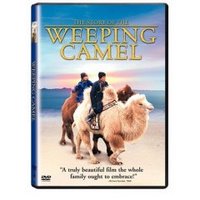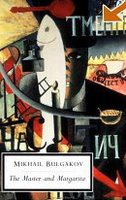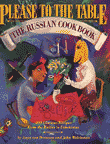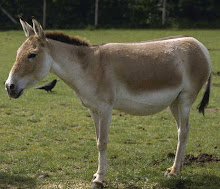Synchronicity abounds. I found this 30-second clip from "Lord of the Eagles" today during a random search (my first) on Google video. This version has French-accented French narration, but all the major players appear -- Alik, son Nurlan, and the mighty Tengere.
Thursday, September 28, 2006
Tuesday, September 26, 2006
Father of Eagles

Every so often, when at the public library, I’ll type “Kazakhstan,” or 'Kazakh” in the catalog search box, just to see what shows up. A few months ago, this casual search turned up a real gem -- a documentary video called Lord of the Eagles, that I’d never heard of, or seen any reference to at all. This 26-minute film, originally released around 1991, is a strange and beautiful animal -- French-produced, filmed in Soviet Kazakhskaya, with Kazakh dialogue and French-accented English narration. Nonetheless, this documentary won a couple of nice awards when it was released in the US.
After keeping it for a while (and racking up some overdue fines), I watched this short film, which then became part of my more-or-less circumnavagatory tour around KZ.
This is a wonderful piece, documenting the Kazakh eagle hunters of the Tien Shan (the mountain range south of Alma-Ata/Almaty). Cultures around the world have traditions of training hunting birds, such as falcons and hawks. The Eastern Kazakhs (I assume the Greater Horde) paired with the great Golden Eagle, which, as a bird of prey, is capable of bringing down even foxes and wolves, whose pelts are the livelihood of the eagle masters.
Lord of the Eagles follows Alik, known as “the father of the birds” and his golden eagle partner Tengere, over their last season together. During this time, Alik teaches his young son Nurlan (who’s about ten years old) the secrets of the eagles -- their language, and the rhythms of a partnership. They capture a younger eagle, whom they name Keitan, and Nurlan becomes Keitan’s partner, learning from father to son, teaching and learning from from eagle to boy, how to work together as a symbiotic team. The eagle is symbolic of, as Alik says, “the beauty and the cruelty of the world.”
In a way (intentional? who knows?), Lord of the Eagles is also a metaphor for the journey though parenting. One of the themes of the documentary is that it’s time to set Tengere free, to find a wife and have a family. Alik says “I have been ten years with Tengere. Tomorrow, I will let him go.” Human parents generally have more than ten years, but we all reach the point of letting go. Would that we all do it as gracefully as Alik does his partner Tengere.
I have yet to find a copy of this video for sale. Keep checking Amazon.com and eBay, but in the meanwhile, check the catalog at your local public library (which probably owns more on Central Asia than you thought). You might find your own undiscovered gems. And then, please, pass them on to the rest of us.
Thursday, September 21, 2006
Finding the Aral Sea (sort of)
 Journalist Tom Bissell’s Chasing the Sea: Lost Among the Ghost of Empire in Central Asia, a non-fiction travel history and memoir, turns out to be less about the death of the Aral Sea (shared by Kazakhstan and the NW Uzbekistan region of Karakalpakistan), and more about the culture, politics and history of the people of Uzbekistan. Bissell was an abject failure as a Peace Corps volunteer in Uzbekistan -- he had a total physical and emotional breakdown and left within the first six months of his tour. Revisiting those ghosts, he returned to Uzbekistan five years later (in 2001) on assignment to write an article about the Aral Sea (his conclusion -- the Uzbek side is a lost cause). Before he ever gets to Karakalpakistan, though, Bissell visits Samarkand, Bukhara, his Peace Corps host family, and makes a side trip through Kyrgystan for the funeral of an Uzbek mountain climber. He ponders on the influence of a fierce and unforgiving environment on the development of bloody and corrupt empires (both past and present). It’s well-written and engaging, with occasional wise observations and laugh-out-loud ironic comments.
Journalist Tom Bissell’s Chasing the Sea: Lost Among the Ghost of Empire in Central Asia, a non-fiction travel history and memoir, turns out to be less about the death of the Aral Sea (shared by Kazakhstan and the NW Uzbekistan region of Karakalpakistan), and more about the culture, politics and history of the people of Uzbekistan. Bissell was an abject failure as a Peace Corps volunteer in Uzbekistan -- he had a total physical and emotional breakdown and left within the first six months of his tour. Revisiting those ghosts, he returned to Uzbekistan five years later (in 2001) on assignment to write an article about the Aral Sea (his conclusion -- the Uzbek side is a lost cause). Before he ever gets to Karakalpakistan, though, Bissell visits Samarkand, Bukhara, his Peace Corps host family, and makes a side trip through Kyrgystan for the funeral of an Uzbek mountain climber. He ponders on the influence of a fierce and unforgiving environment on the development of bloody and corrupt empires (both past and present). It’s well-written and engaging, with occasional wise observations and laugh-out-loud ironic comments.Though they share a fairly long border, Uzbekistan and Kazakhstan do not share the exact same histories. The cultures spread along the Silk Road touched the southern parts of Central Asia, only occasionally moving through what is now Kazakhstan. Kazakhstan was long populated by nomadic groups, moving to the best grazing areas with the seasons. Nomads are notoriously hard to govern -- as Hugh Pope writes in Sons of the Conquerers, you can’t rule (or convert) people you can’t find. Further south, away from the steppes, the people were more settled, which gave rise to cities, trade, science, architecture, more religion and a different kind of literary culture. Even the music has a different sound and purpose -- urban vs. nomadic. But that’s a different book review altogether . . .
I’ve been musing on the state of Central Asian scholarship, at least as it is published in English. In the past decade or so (since the fall of the Soviet Union), most research and writing on the region has been done by scholars trained in Soviet studies (Martha Brill Olcott, a fine thinker and scholar, is an example), so their insights and analysis are virtually always from the Russian perspective. A few researchers approach the region from the Islamic or Turkic perspective, either fretting about Islamic fundamentalism, or seeing all speakers of Turkic languages as little cousins of Turkey. A small, but hopefully growing, new breed of Central Asian scholars is emerging. Their interest begins in Central Asia -- from Kazakhstan, Kyrgistan, Uzbekistan -- and radiates outward from that center. Tom Bissell’s book is an example of this viewpoint. His interest in Central Asia comes solely from his experiences in Uzbekistan, so all of his research, scholarship and writing radiates from that center. Two places for Central Asian-centric thinking are Registan ("All Central Asia, All The Time"), a blog with politics and cultural analysis, originated by a former Peace Corps volunteer to Uzbekistan and current graduate student in Central Asia studies, and The Roberts Report, by a professor of Central Asian Studies at Georgetown University. Recently, another website, KZBlog, has revived, with a focus on culture and daily life (as viewed by an American working long-term in KZ). Politics (however entertaining) are not the focus of News from the Caravan -- check out these sites to keep up on the latest events.
Sunday, September 17, 2006
Circling KZ in Books and Film
Greetings! After a summer-long hiatus, spent in a state a whole lot greener and only slightly less land-locked than anywhere in Central Asia, I resume. Over the past few months, I’ve vicariously circled around Kazakhstan, having watched a couple of documentary-type films and read a few books, all of which touch on Soviet Central Asian history and/or culture, but not a one of which is about Kazakhstan directly. It’s been fascinating.
First, a film and a book --
 The National Geographic feature film Story of the Weeping Camel, isn’t exactly a documentary and isn't exactly fiction, but a little of both. It’s filmed in the Mongolian desert, and tells the story of a rare baby white camel that is rejected from birth by its mother. The family of herders try one strategy after another to encourage, teach, trick and cajole the mother camel into caring for the starving and sad baby until at last, traditional Mongolian music and song break through to her stony heart. The daily life and customs of these nomads seems very similar to that of the ethnic Kazakhs, who also live in Mongolia and China in addition to Kazakhstan. The portrayal of the family of nomads -- a cluster of three gers (the Mongolian yurta) houses young parents with two sons, and two sets of grandparents -- makes clear details that are hard to figure out from just words and pictures. How exactly do those flaps on the yurta work? Seeing the father prepare for an impending sandstorm explains all.
The National Geographic feature film Story of the Weeping Camel, isn’t exactly a documentary and isn't exactly fiction, but a little of both. It’s filmed in the Mongolian desert, and tells the story of a rare baby white camel that is rejected from birth by its mother. The family of herders try one strategy after another to encourage, teach, trick and cajole the mother camel into caring for the starving and sad baby until at last, traditional Mongolian music and song break through to her stony heart. The daily life and customs of these nomads seems very similar to that of the ethnic Kazakhs, who also live in Mongolia and China in addition to Kazakhstan. The portrayal of the family of nomads -- a cluster of three gers (the Mongolian yurta) houses young parents with two sons, and two sets of grandparents -- makes clear details that are hard to figure out from just words and pictures. How exactly do those flaps on the yurta work? Seeing the father prepare for an impending sandstorm explains all.
10/2/2006 -- National Geographic has a great website for this film, with lots of additional information on the land, people, traditions and animals of the Gobi Desert.
 Then north and west to Russia: After a third person said to me "surely you've read The Master and Margarita
Then north and west to Russia: After a third person said to me "surely you've read The Master and Margarita ," (and I hadn't), I began this satiric novel by Mikhail Bulgakov. What happens when Satan in disguise pays a visit to fervently athiestic Soviet Moscow, and what has Pontius Pilate got to do with it all? Bulgakov began the novel in 1928, burned it (just as the Master burns his manuscript after intense negative criticism), picked it up again in the 1930s, and worked on it off and on 'til his death. His wife finished and polished the novel, which is now regarded as one of the greatest Russian novels of the 20th century. In a bitingly funny and fantastical way, Bulgakov’s story shreds the pretenses of the Communist literary scene and the immobility of Soviet society, assails the quality of party poetry, and rewards courage and steadfast devotion in his main characters. And it's quite a good read, too.
," (and I hadn't), I began this satiric novel by Mikhail Bulgakov. What happens when Satan in disguise pays a visit to fervently athiestic Soviet Moscow, and what has Pontius Pilate got to do with it all? Bulgakov began the novel in 1928, burned it (just as the Master burns his manuscript after intense negative criticism), picked it up again in the 1930s, and worked on it off and on 'til his death. His wife finished and polished the novel, which is now regarded as one of the greatest Russian novels of the 20th century. In a bitingly funny and fantastical way, Bulgakov’s story shreds the pretenses of the Communist literary scene and the immobility of Soviet society, assails the quality of party poetry, and rewards courage and steadfast devotion in his main characters. And it's quite a good read, too.
Next stop, to Uzbekistan, the country that shares the Aral Sea with Kazakhstan, with Chasing the Sea: Lost Among the Ghosts of Central Asia, by former Peace Corps volunteer Tom Bissell. More about this fascinating book next time . . .
First, a film and a book --
 The National Geographic feature film Story of the Weeping Camel, isn’t exactly a documentary and isn't exactly fiction, but a little of both. It’s filmed in the Mongolian desert, and tells the story of a rare baby white camel that is rejected from birth by its mother. The family of herders try one strategy after another to encourage, teach, trick and cajole the mother camel into caring for the starving and sad baby until at last, traditional Mongolian music and song break through to her stony heart. The daily life and customs of these nomads seems very similar to that of the ethnic Kazakhs, who also live in Mongolia and China in addition to Kazakhstan. The portrayal of the family of nomads -- a cluster of three gers (the Mongolian yurta) houses young parents with two sons, and two sets of grandparents -- makes clear details that are hard to figure out from just words and pictures. How exactly do those flaps on the yurta work? Seeing the father prepare for an impending sandstorm explains all.
The National Geographic feature film Story of the Weeping Camel, isn’t exactly a documentary and isn't exactly fiction, but a little of both. It’s filmed in the Mongolian desert, and tells the story of a rare baby white camel that is rejected from birth by its mother. The family of herders try one strategy after another to encourage, teach, trick and cajole the mother camel into caring for the starving and sad baby until at last, traditional Mongolian music and song break through to her stony heart. The daily life and customs of these nomads seems very similar to that of the ethnic Kazakhs, who also live in Mongolia and China in addition to Kazakhstan. The portrayal of the family of nomads -- a cluster of three gers (the Mongolian yurta) houses young parents with two sons, and two sets of grandparents -- makes clear details that are hard to figure out from just words and pictures. How exactly do those flaps on the yurta work? Seeing the father prepare for an impending sandstorm explains all.10/2/2006 -- National Geographic has a great website for this film, with lots of additional information on the land, people, traditions and animals of the Gobi Desert.
 Then north and west to Russia: After a third person said to me "surely you've read The Master and Margarita
Then north and west to Russia: After a third person said to me "surely you've read The Master and MargaritaNext stop, to Uzbekistan, the country that shares the Aral Sea with Kazakhstan, with Chasing the Sea: Lost Among the Ghosts of Central Asia, by former Peace Corps volunteer Tom Bissell. More about this fascinating book next time . . .
Subscribe to:
Posts (Atom)

